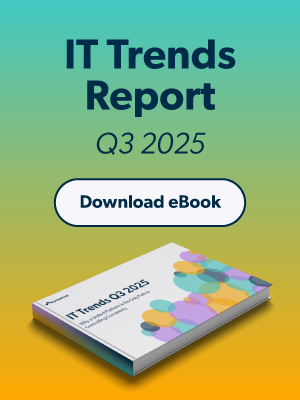Updated on May 21, 2025
Mobile devices are essential for modern businesses, helping both executives and employees stay productive. But as their use grows, so do security risks, making effective management crucial. Mobile Threat Defense (MTD) helps protect devices from cyberattacks while ensuring workflows aren’t disrupted.
This article breaks down what MTD is, how it works, its key features, and why it’s a must-have for IT professionals and administrators.
What Is Mobile Threat Defense (MTD)?
Mobile Threat Defense (MTD) is a security tool designed to protect mobile devices from threats. Unlike standard antivirus software, MTD is made specifically for mobile systems like iOS and Android. It addresses risks like malicious apps, phishing scams, unsafe networks, and outdated software.
As mobile devices become more central to work—whether for accessing sensitive data or supporting remote teams—MTD provides crucial protection. By tackling mobile threats head-on, MTD keeps devices secure, protects data, and strengthens organizational security.
MTD solutions typically integrate with Mobile Device Management (MDM) or Enterprise Mobility Management (EMM) systems, enabling IT administrators to deploy holistic mobile security strategies seamlessly.
Types of Threats Addressed by MTD
- Malware: Mobile-centric malware installs itself on devices to steal credentials, intercept sensitive information, or take control of device functionality.
- Phishing: Advanced phishing scams target mobile users via SMS, email, and browser-based exploits.
- Network Attacks: Tactics, such as man-in-the-middle (MitM) attacks, intercept communications on unsecured networks.
- Device Vulnerabilities: Outdated operating systems or misconfigured settings leave devices exposed to exploitation.
Key Features of Mobile Threat Defense
Mobile Threat Defense solutions are designed with advanced features that make identifying and addressing threats easy and effective. Below are the core functionalities these solutions deliver:
Threat Detection
- Identifies malicious apps, unsafe software, and known vulnerabilities in a device’s configuration.
- Detects phishing scams before users fall victim by analyzing links in emails, SMS, and web activity.
Network Protection
- Monitors unsecured Wi-Fi connections to block dangerous activities.
- Detects MitM attacks, ensuring that communications between users and business-critical apps remain secure.
Behavioral Analysis
- Analyzes patterns in device and app usage to identify unusual or potentially unauthorized activities.
- Employs machine learning to adapt to emerging threats in real time.
Remediation Capabilities
- Triggers automated responses, such as quarantining suspicious apps or enforcing updates, based on predefined security policies.
- Empowers IT administrators with guided actions to quickly address identified threats.
Integration with the Security Ecosystem
- Seamlessly connects with other IT tools like SIEM (Security Information and Event Management) platforms for centralized threat reporting.
- Integrates with popular MDM and EMM platforms to create a cohesive device management strategy.
User Awareness
- Sends alerts to end-users about risky behavior, helping them make better security decisions (e.g., avoiding the use of unsecured networks).
How MTD Works
Mobile Threat Defense ensures security by using advanced detection, analysis, and protection technologies. Here’s how it works:
App and Device Scanning
MTD continuously monitors:
- Installed apps to identify malicious software or atypical permission requests.
- Device configurations for vulnerabilities, such as missing updates or weak passcodes.
Network Monitoring
Real-time network analysis is conducted to:
- Detect suspicious traffic patterns on Wi-Fi networks.
- Identify MitM attacks that attempt to intercept communications between users and applications.
Threat Intelligence Integration
MTD solutions leverage global threat intelligence databases to predict and protect against the latest vulnerabilities and exploits.
User Alerts and Actions
When suspicious activity is detected, users are immediately notified via their MTD app, often accompanied by remediation instructions. Actions such as disabling compromised apps or restricting access are executed automatically.
MTD provides real-time visibility into app activity, network traffic, and threat intelligence, making mobile security more proactive and effective.
Benefits of Mobile Threat Defense
Using Mobile Threat Defense benefits organizations by enhancing security for IT administrators while maintaining productivity.
- Enhanced Security: Protects sensitive data stored on, or accessed through, mobile devices.
- Regulatory Compliance: Aids compliance with regulations, such as GDPR and HIPAA, by addressing mobile-specific vulnerabilities.
- Improved User Productivity: Secures device usage without disrupting workflows, maintaining an optimal user experience.
- Cost Savings: Reduces the risk of data breaches that can lead to significant financial losses and reputational harm.
- Scalability: Adapts to businesses of any size, from startups to global enterprises, offering flexible deployment models.
Challenges of MTD Implementation
Despite its benefits, organizations may face challenges when implementing MTD solutions:
- User Privacy Concerns: Employees using personal devices fear their privacy will be compromised through monitoring. Solutions need to ensure clear communication and privacy-respecting policies.
- Compatibility Issues: Legacy platforms or niche systems may not integrate smoothly with certain MTD solutions, creating short-term implementation hurdles.
- Cost: Some small organizations may face challenges justifying the cost of MTD tools against perceived risks.
- False Positives: Overloading IT teams with unnecessary alerts can reduce their effectiveness in addressing genuine threats. Fine-tuning alert thresholds is crucial.
Use Cases and Applications
MTD solutions have broad applications across industries and environments. Common use cases include:
BYOD (Bring Your Own Device) Environments
MTD secures personal devices used for accessing business resources, balancing convenience with robust security controls.
Remote Workforce Security
With more employees working outside traditional office networks, MTD protects organizations by securing access to internal systems from any location.
Highly Regulated Industries
Organizations in healthcare, finance, or government sectors use MTD to ensure compliance with strict data protection requirements.
Incident Response
MTD tools provide insights critical for analyzing post-attack scenarios, improving future security strategies.
Key Criteria for Selecting MTD
- Integration: Ensure seamless compatibility with existing tools such as MDM or IAM (Identity Access Management) systems.
- Ease of Use: Solutions should be intuitive, minimizing employee learning curves and IT overhead.
- Scalability: Evaluate whether the solution can scale alongside growing or evolving business requirements.
Trends in the MTD Market
- AI-Driven Analysis: Increased reliance on artificial intelligence to enhance threat detection accuracy.
- Zero-Trust Approaches: Strengthened adoption of zero-trust security with tighter access controls and network segmentation.
Glossary of Terms
- Mobile Threat Defense (MTD): Solutions designed to secure mobile devices by detecting, preventing, and mitigating unique threats.
- Man-in-the-Middle (MitM) Attack: A cyberattack where an attacker intercepts or manipulates communication between two parties without their knowledge.
- Mobile Device Management (MDM): Tools for centrally managing and securing mobile devices within an organization.
- Enterprise Mobility Management (EMM): A broader term, integrating MDM with app and content management for secure mobile operations.
- Threat Intelligence: Data collected and analyzed to proactively identify and respond to potential cyber threats.






